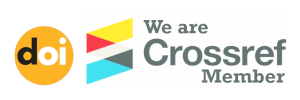Submissions
Submission Preparation Checklist
As part of the submission process, authors are required to check off their submission's compliance with all of the following items, and submissions may be returned to authors that do not adhere to these guidelines.- The submission has not been previously published, nor is it before another journal for consideration (or an explanation has been provided in Comments to the Editor).
- The submission file is in OpenOffice, Microsoft Word, or RTF document file format.
- Where available, URLs for the references have been provided.
- The text is single-spaced; uses a 12-point font; employs italics, rather than underlining (except with URL addresses); and all illustrations, figures, and tables are placed within the text at the appropriate points, rather than at the end.
- The text adheres to the stylistic and bibliographic requirements outlined in the Author Guidelines.
Research Article
- Open submission
- Indexed
- Peer reviewed
These are primary publications reporting on original research. They typically include sections such as introduction, methodology, results, discussion, and conclusion.
Review Article
- Open submission
- Indexed
- Peer reviewed
These provide a comprehensive summary and evaluation of existing research on a particular topic. They often analyze multiple studies to draw conclusions about the state of knowledge in a field.
Case Study
- Open submission
- Indexed
- Peer reviewed
These present detailed analyses of specific cases or examples, often used in fields like psychology, sociology, and medicine to illustrate broader principles or phenomena.
Technical Article
- Open submission
- Indexed
- Peer reviewed
A technical article is a specialized form of academic writing that focuses on explaining complex technical concepts, procedures, or advancements within a specific field or industry. These articles are typically targeted towards professionals, researchers, or practitioners who have a deep understanding of the subject matter.
Short Communication
- Open submission
- Indexed
- Peer reviewed
Short communications, also known as brief communications or rapid communications, are concise and focused research articles that typically report on significant findings or developments in a relatively brief format.
Editorial
- Editors only
- Indexed
- Not peer-reviewed
These are opinion pieces written by the editorial board or invited experts, often discussing current events, trends, or debates within the field.
Book Review
- Open submission
- Indexed
- Peer reviewed
These assess the content, significance, and quality of a book within a specific field, offering insights to potential readers.
Letters to the Editor
- Open submission
- Indexed
- Peer reviewed
These are short communications addressing issues raised in previously published articles or discussing recent developments in the field.
Copyright Notice
The author/s retains all copyrights and publishing rights.
The authors retain copyright in published papers and grant the publisher a non-exclusive license to publish the article, be cited as the article's original publisher in the event of reuse, and disseminate it in any form or medium.
All versions of the work can be deposited in an institutional or subject repository by the authors.
- Preprint
- Author's Accepted Manuscript
- Published article (Version of Record)
The Journal permits Authors to deposit all versions of their paper in institutional repositories and non-commercial subject-based repositories such as PubMed Central, Europe PMC, arXiv, and other repositories, as well as to publish it on the Author's personal and departmental websites (including social networking sites, such as ResearchGate, Academia.edu, etc.).
Copyright and source must be acknowledged, and a link to the article's DOI must be included.
Privacy Statement
The information collected from registered and non-registered readers of this journal is standard practice in peer-reviewed publications. It contains information that facilitates editorial communication; it is used to inform readers about the authorship and content editing. It allows for the collection of aggregated statistics on reading behaviors and the tracking of geopolitical and social aspects of scholarly communication. The information is securely saved on a Sprin Publisher server.
The editorial staff of this publication uses this data to influence their publishing work and enhance it. With applicable exclusions, such as article metrics, data that may aid in developing this publishing platform may be shared with its creator Public Knowledge Project in an anonymized and aggregated form. This journal and PKP will not sell or use data other than those indicated below. The human subject data used in the study presented here is the responsibility of the authors who have been published in this journal.
The editors of this journal aim to comply with industry data privacy standards, such as the European Union's General Data Protection Regulation (GDPR), which includes "data subject rights" such as (a) breach notification; (b) right of access; (c) right to be forgotten; (d) data portability; and (e) privacy by design. The GDPR also recognizes "the public interest in the data's availability," which is especially important for those responsible for keeping the public record of scholarly publications as accurate as feasible.


